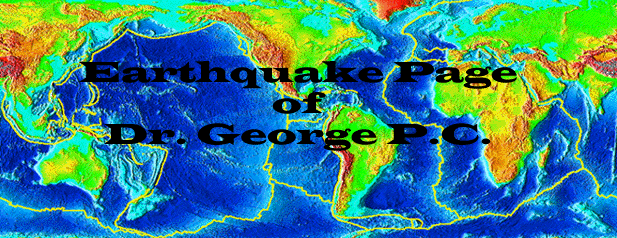Hurricane
Iniki of September 5 - 13, 1992 in the Hawaiian Islands
Examination
of its Anomalous Path
George
Pararas-Carayannis
(©) Copyright
2007 George Pararas-Carayannis

INTRODUCTION
The last hurricane
to strike the Hawaiian Islands was Iniki in 1992. Iniki was a small but intense hurricane (minimal category
Four) which made
landfall on Kauai where it killed six people and caused $2.5
billion in damage. Until the 2005 Hurricane Katrina, Iniki was
the thrd most destructive hurricane in U. S. history and the
most destructive to hit the Hawaiian Islands in the 20th Century.
On the average , the
Hawaiian Islands region gets an average of 4.5 tropical storms
per year and one hurricane approximately every 15 years. Most
of the tropical depressions in this central region of the Pacific,
usually pass south of the Island of Hawaii amd bring heavy rains
but do not cause major problems to the Islands. However, Iniki
was an exception and an anomaly that could very well occur again
in the future. What was unusual about Iniki was the sudden change
of its track path in a northward direction in the morning hours
of September 10, 1992 and its intensity when it made landfall
on Kauai. A detailed description of Iniki's winds and surge flooding
effects in Kauai were provided previously in another report (http://www.drgeorgepc.com/HurricaneIniki.html ). The present report examines
the 1992 high hurricane and storm activity in the Eastern Pacific
Region and the causes that steered Iniki northward to strike
Kauai. Another report provides an overall risk assessment of
hurricanes in the Hawaiian Islands and presents a scenario of
the potential impact that a hurricane, similar to Iniki, would
have if it made landfall on the southern coast of Oahu, or passed
in closer proximity to a metropolitan area such as Honolulu.

Iniki's
Formation:
As illustrated in
the diagram below, 1992 - an El Nino year - was prolific for
hurricanes and storms in the Eastern and Central Pacific.

Tracks
of Storm Systems and Hurricanes in the Eastern Pacific in1992,
including Hurricane Iniki
Iniki formed as a
tropical depression near 12 N 135 W on September 5, 1992, about
1600 statute miles southwest of Baja California - crossing 140
W into the Central Pacific on the morning of September 6.
As the depression
moved westward, it began to intensify and was upgraded to a tropical
storm on the 8th of September. Iniki was further upgraded from
a tropical storm to a hurricane when it was near 13 N, 152 W,
or about 470 miles SSE of Hilo.
Hurricane Iniki continued
to strengthen while on a west-northwest course - passing 300
miles south of South Point of the Island of Hawaii. When it was
located near 14 N 156 W, or about 385 miles SSW of Hilo, its
maximum sustained winds had reached 85 knots. Iniki continued
in a west-northwest direction at a speed of translation ranging
between 12 and 15 knots on September 9, and was near 15 N 158
W, or about 425 miles south of Honolulu. During the morning hours
of September 10, at about 5 am HST Iniki was near 15 N 159 W
or about 410 miles south of Honolulu. At that time Iniki began
to slow its forward motion speed but continued moving in a generally
west-northwest direction at about 10 knots. At the time, maximum
winds had reached 100 knots and the central pressure was 951
millibars. Then Iniki slowed even more and started to turn in
a northwest direction. When its center was near 15 N 160 W, or
about 400 miles south of Lihue, Kauai, the storm system had strengthened
with maximum winds estimated at 110 knots and gusts up to 135
knots. Then suddenly, Iniki changed completely direction and
begun to move northward towards the island of Kauai.
 Watches and Warnings
for Iniki:
Based on these changes
a hurricane watch was issued for the western Hawaiian chain from
Kauai and Niihau, west to French Frigate Shoals on September
10, 1992. On the morning of September 11, hurricane warnings
were issued for Kauai and Niihau and tropical storm warnings
were issued for Oahu. A tropical storm watch was issued for the
Islands of Maui, Lanai and Molokai. High Surf Advisories were
continued for all of the Hawaiian chain. Watches and Warnings
for Iniki:
Based on these changes
a hurricane watch was issued for the western Hawaiian chain from
Kauai and Niihau, west to French Frigate Shoals on September
10, 1992. On the morning of September 11, hurricane warnings
were issued for Kauai and Niihau and tropical storm warnings
were issued for Oahu. A tropical storm watch was issued for the
Islands of Maui, Lanai and Molokai. High Surf Advisories were
continued for all of the Hawaiian chain.
Track of Hurricane
Iniki, in 5-13 September 1992.
Iniki's
Track Before Landfall on Kauai: Iniki continued to turn more northward while
accelerating. Iniki was well-tracked and average wind velocities
and maximum winds were fairly well estimated or measured by aerial
reconnaissance dropsondes during its fully developed phase on
the 10th and 11th September 1992.
Iniki continued to strengthen during the early morning hours
of September 11 as it moved north along 160W. At 0900Z, on September
11, Iniki was located near 17.5 N 160 W or 310 miles south of
Lihue and continued to move north with a speed of translation
of 12 knots. Hurricane warnings were extended eastward to include
the island of Oahu. By 2100Z, of September 11th, Iniki was near
20 N 160 W , or about 130 miles south southwest of Lihue>
It continued to move north or a bit east of north but its speed
of translation had increased to 15 knots. Maximum sustained winds
had increased and were estimated at 125 knots with gusts as high
as 150 knots. The central pressure was measured to be 938 millibars
- the lowest pressure ever recorded in a Central Pacific hurricane
up to that time.
 Iniki's Landfall and Departure: Iniki
moved faster north, rapidly approaching the southern Kauai coast.
At 12/0100Z its center was located near 21.6 N 159.7 W or 37
miles southwest of Lihue. The central pressure was 945 millibars
and maximum winds were about 127 knots. In the afternoon of September
11, at 3:30 pm HST, the eye of Iniki crossed Kauai's south coast,
just west of Port Allen near Kaumakani, just east of Waimea.
When Iniki moved over Kauai, its central pressure was approximately
945 millibars, and the estimated maximum sustained winds over
land were 145 mph, with gusts up to 175 mph miles - making Iniki
the most powerful hurricane to strike the Hawaiian Islands in
recent history. Iniki moved on a bearing of about 15 degrees
on the compass across Kauai while accelerating to 25 knots. Fortunately,
Iniki moved fast over Kauai and departed Haena on the north coast
about 40 minutes after landfall. Subsequently, it continued north
and, at 12/0300Z, was centered 50 miles north of Kauai's Na Pali
coast. By that time Kauai was in ruins. Iniki's Landfall and Departure: Iniki
moved faster north, rapidly approaching the southern Kauai coast.
At 12/0100Z its center was located near 21.6 N 159.7 W or 37
miles southwest of Lihue. The central pressure was 945 millibars
and maximum winds were about 127 knots. In the afternoon of September
11, at 3:30 pm HST, the eye of Iniki crossed Kauai's south coast,
just west of Port Allen near Kaumakani, just east of Waimea.
When Iniki moved over Kauai, its central pressure was approximately
945 millibars, and the estimated maximum sustained winds over
land were 145 mph, with gusts up to 175 mph miles - making Iniki
the most powerful hurricane to strike the Hawaiian Islands in
recent history. Iniki moved on a bearing of about 15 degrees
on the compass across Kauai while accelerating to 25 knots. Fortunately,
Iniki moved fast over Kauai and departed Haena on the north coast
about 40 minutes after landfall. Subsequently, it continued north
and, at 12/0300Z, was centered 50 miles north of Kauai's Na Pali
coast. By that time Kauai was in ruins.
Satellite image of
Hurricane Iniki on September 11, 1992 at 2358 UTC (NOAA Image)
The hurricane warning for Oahu was subsequently downgraded to
a tropical storm warning. The tropical Storm Warning for Oahu
and Maui County was canceled at 12/0600Z when Iniki was 120 miles
north of Kauai moving north , now at 25 knots and weakening,
with top winds down to 100 knots. The hurricane warning for Kauai
was downgraded to a tropical storm watch at 12/0900Z. The watch
was then cancelled at 12/1200Z.
 The eye of the Iniki crossed
the Kauai Coast just west of Port Allen near Kaumakani just before
4 PM Hawaiian Standard Time (HST). The most severe damage in
Kauai occurred on the south, east and north of the island. The eye of the Iniki crossed
the Kauai Coast just west of Port Allen near Kaumakani just before
4 PM Hawaiian Standard Time (HST). The most severe damage in
Kauai occurred on the south, east and north of the island.
Iniki continued to
move north and to weaken. At 12/2100Z, it was located 500 miles
north of Kauai, near 29 N 159 W, with maximum winds now down
to about 80 knots. It decreased to tropical storm strength by
13/1500Z near 36 N 158 W and was considered extratropical as
it continued to move north, while entangling itself with an approaching
low pressure system and a cold front.
Winds on
Oahu: The most severe
conditions from Iniki - measured at Wheeler Air Force Base on
11 September 1992 - were winds of 29 knots from the Southeast,
gusting to 47 knots. The wind directions changed from 275 to
104 degrees. At Barber's Point the winds were from the Southeast
at 34 knots gusting to 45 knots.
Storm Surges
on Kauai:
Iniki was accompanied
by storm tides ranging from 4.5 to 6.3 feet above normal, with
20 to 35 foot storm waves superimposed. Heavy waves battered
the coastal areas of southern Kauai. Highest values occurred
at Port Allen and Poipu. Maximum flooding begun around 3:30,
as indicated by the Port Allen tide gauge, prior to the passage
of the hurricane's eye nearby. At that time the astronomical
tide was the highest and it was augmented by the reduction of
the barometric pressure as the hurricane moved over the island.
Superimposed on the higher elevation of the hurricane surge were
the storm waves, which intensified around that time, as the winds
were maximum and the landward component of wind friction also
reached maximum value.
Aerial photo of
debris line (innermost white line) at Poipu Beach, Kauai, illustrating
the degree of Iniki's hurricane storm surge flooding.
 The highest water levels and
inundation of up to 22 feet above mean lower low water (MLLW)
were reported by the Army Corps of Engineers near the Poipu area
of Kauai. However, flooding of up to 27 feet above MLLW was reported
by the Civil Defense. A University of Hawaii survey claimed maximum
inundation of 29 feet above MLLW. The highest water levels and
inundation of up to 22 feet above mean lower low water (MLLW)
were reported by the Army Corps of Engineers near the Poipu area
of Kauai. However, flooding of up to 27 feet above MLLW was reported
by the Civil Defense. A University of Hawaii survey claimed maximum
inundation of 29 feet above MLLW.
Storm Suges
on Oahu:
On Oahu, Iniki produced
tides of 1.7-3 feet (0.5-0.9 m) above normal. Superimposed on
the elevated height of the sea were the storm waves. Prolonged
periods of high waves severely eroded and damaged the southwestern
coast of Oahu, with the areas most affected being Barbers Point
through Kaena Point. The Waianae coastline experienced the most
damage, with waves and storm surge flooding the second floor
of beachside apartments. In all, hurricane Iniki caused several
million dollars in property damage, and 2 deaths on Oahu.
Water Level
Measuring Stations:
On Kauai, the NOS
tide station at Port Allen was the only continuous recording
of water level as affected by hurricane Iniki. On Oahu a continuous
recording of water level was made by the NOS tide station at
the Coast Guard pier in Honolulu Harbor. These stations also
recorded the barometric pressure fluctuations. Deep water buoy
51002, anchored some 280 miles south southeast of Honolulu, had
recorded significant wave heights of about 20 feet, which would
indicate a most probable wave height of about 36 feet, which
was consistent with what was observed along the south shore of
Kauai.
Wind Reporting
Stations:
There is no much
wind data collected for hurricanes occurring in the vicinity
of the Hawaiian Islands because most of the recording stations
are on land and separated by great distances. The only deep ocean
buoy (510020) - close enough to record wind and wave data for
Iniki - is anchored about 280 miles south southeast of Honolulu.
On the island of Kauai, only WSO Lihue, the Navy station at Barking
Sands, and stations at Makahuena, Princeville, Makaha Ridge,
and Port Allen provided some wind data - some of the time. There
is not a great deal of wind data for the southern part of the
island of Kauai and very little data for Oahu. The only stations
that reported briefly wind data from Kauai were Port Allen and
Makahuena (until it lost power).
Iniki's
Damage and Destruction: The
most severe damage occurred on the south, east and north of Kauai.
Surge damage was heaviest along the south shore of Kauai and
affected shoreline hotels and condominiums, especially around
Poipu. Extensive wind damage begun in the Poipu area as early
as 1:15 to 1:30 in the early afternoon of September 11. Wind
damage was extremely heavy throughout Kauai as many homes and
buildings were flattened or lost their roofs. The number of homes
that were completely destroyed was 1,421. A total of 63 homes
were destroyed by wave action or storm surges on the south coast
of the island. The number suffering major damage was 5,152 while
7,178 received minor damage. Electric power and telephone service
were lost throughout the island and only 20 percent of power
had been restored four weeks after the storm. Crop damage was
likewise extensive as sugar cane was stripped or severely set
back, while tropical plants, such as banana and papaya, were
destroyed and fruit and nut trees were broken or uprooted. The
overall monetary value of the damage caused by Iniki in the Hawaiian
Islands reached close to 3 billion dollars.
Some damage also occurred on the islands of Maui County and the
Big Island of Hawaii, where swells and heavy surf from southwesterly
directions pounded exposed shorelines and anchorages.
On Oahu, the areas most affected were the leeward coast from
Barbers Point through Makaha and Kaena Point, with lesser damage
along the south shore from Ewa Beach to Hawaii Kai.
Iniki's
Anomalous Path:
In the early morning
hours of September 10, 1992, Iniki was located near 15 N 159
W, or 410 miles south of Honolulu, but still moving in a generally
west direction at 10 knots. It looked as though it would miss
the islands. However, subsequent unpredictable flow changes in
the overall Central Pacific circulation changed Iniki's path
to a northward direction. What deflected Iniki's path in a northward
direction was the fact that the western edge of the subtropical
high-pressure ridge, a semi permanent feature found north of
Hawaii, had weakened. Normally, this pressure ridge keeps hurricanes
south of the islands. However, in September 1992, a weakness
in this ridge had developed west of 160 W when a large low system
or trough began to drift south along and just east of the International
Dateline at 180 W. This air mass flow change caused Iniki to
change its path in the early hours of September 10 and head north
of its previous west-northwest track - bringing it closer to
the islands.
Other 1992
Hurricanes and Storm Systems in the vicinity of the Hawaiian
Islands after Iniki
In the days and weeks
following Iniki, the Hawaiian Islands were affected by four additional
storm systems.
Hurricane
Roslyn - September 24 - 30, 1992: Hurricane Roslyn moved into the Central North
Pacific area early on September 24, crossing at 140 W near 18
N with winds estimated at 75 knots. Roslyn weakened as it moved
slowly westward along 18 N and was downgraded to a tropical storm
24 hours later near 145 W. On the 27th, near 18N 150W, shearing
aloft occurred and the weakened system began to move northeast
and later north over the waters northeast of the Hawaiian Islands
where it dissipated. The only effect the weakening cyclone had
on the Hawaiian Islands was some higher than normal surf along
its eastern shores.
Tropical
Depression Tina - October 9 - 11, 1992: Tropical
Depression "Tina" crossed into the central North Pacific
on October 9 near 24 N 140 W. "Tina" dissipated as
it moved in a northerly direction just west of the 140th west
meridian. "Tina" had an unusually long life span, which
lasted nearly 3 weeks. Tina had no significant effect in the
Hawaiian Islands.
Tropical
Depression Yolanda - October 22 - 23, 1992: Tropical
Depression "Yolanda was dissipating by the time it entered
the Central Pacific. It had been sheared and completely stripped
of its deep convection as it reached near 16N 140W moving west
at about 12 km. An advisory was issued early on October 22 on
the dissipating system. The following day the remnant circulation
passed to the south of the Big Island of Hawaii, bringing a few
showers to its windward coast.
Tropical
Depression Three-C - November 21 - 22, 1992: High
sea surface temperatures persisted in the equatorial areas of
the Central Pacific even though the 1991-92 El Nino had officially
ended. As a result, widespread cloudiness and showers persisted
to the south and west of the Hawaiian Islands. A small disturbance
did form within a cloud mass centered near 10 N 150 W. The disturbance
tracked west and developed a closed circulation near 11 N 155
W and was subsequently named Tropical Depression THREE-C late
on November 21. TD3C never developed past the depression stage
and the last advisory was issued about 24 hours later, when the
system was dissipating near 10 N 157 W.

REFERENCES
AND ADDITIONAL READING
Brown R. H. (1993). Natural
Disaster Survey Report: Hurricane Iniki. URL accessed on 2006-03-13.
Central Pacific Hurricane
Center (1992). The
1992 Central Pacific Tropical Cyclone Season. URL accessed on 2006-03-13.
National Hurricane
Center (2004). Costliest
U.S. Hurricanes 1900-2004
(adjusted). URL accessed on 2006-03-18.
Pararas-Carayannis
G. Hurricane Surge
Prediction - Understanding the Destructive Flooding Associated
with Hurricanes http://drgeorgepc.com/HurricaneSurge.html
Pararas-Carayannis
G. HURRICANE INIKI IN THE HAWAIIAN ISLANDS September 11, 1992
http://drgeorgepc.com/HurricaneIniki.html
Pararas-Carayannis, G., 1975. "Verification
Study of a Bathystrophic Storm Surge Model". U.S. Army, Corps of Engineers - Coastal
Engineering Research Center, Washington, D.C., Technical Memorandum
No. 50, May 1975 (Study performed for the U.S. Nuclear Regulatory
Commission for the licencing of the Crystal River (Florida) nuclear
plant).
Pararas-Carayannis, G.,1993. The
Wind and Water Effects from Hurricane Iniki on September 11,
1992, at Lawai Beach Resort, Poipu, Island of Kauai, Hawaiian
Islands. A study
prepared for Metropolitan Mortgage & Securities Co., Inc,
Spokane, Washington,and the Ritter Group of Companies, Chicago,
June, 1993.
US Army Corps of Engineers
(1993). Hurricane
Iniki Assessment.
US Military. URL accessed on 2006-03-13.
 Return to
Return to

  Links to other
Pages
Links to other
Pages


Now available
from Amazon, Barnes and Noble and other major bookstores. A signed
by the author copy can be also ordered by contacting directly
by email Aston
Forbes Press.
 Other
Miscellaneous Non-technical Writings
Other
Miscellaneous Non-technical Writings
 (©) Copyright
1963-2007 George Pararas-Carayannis / all rights reserved / Information
on this site is for viewing and personal information only - protected
by copyright. Any unauthorized use or reproduction of material
from this site without written permission is prohibited.
(©) Copyright
1963-2007 George Pararas-Carayannis / all rights reserved / Information
on this site is for viewing and personal information only - protected
by copyright. Any unauthorized use or reproduction of material
from this site without written permission is prohibited.
|